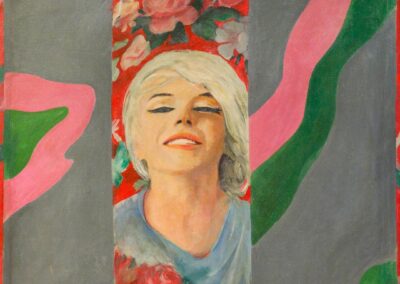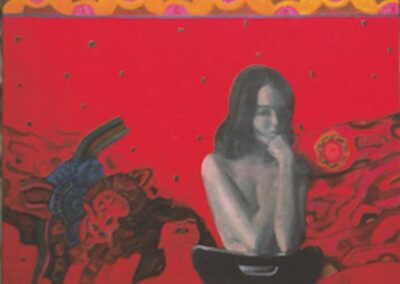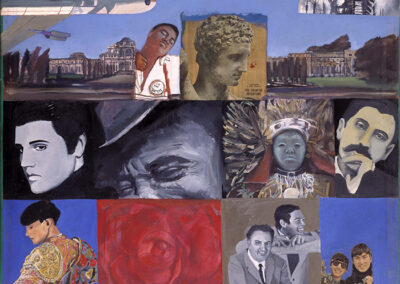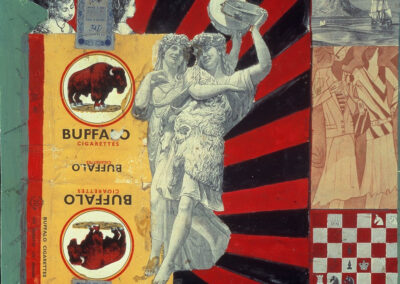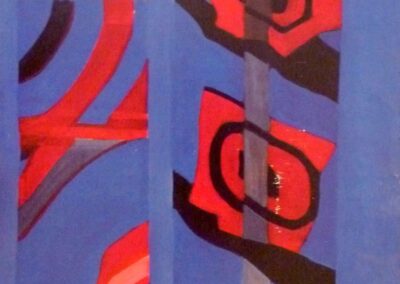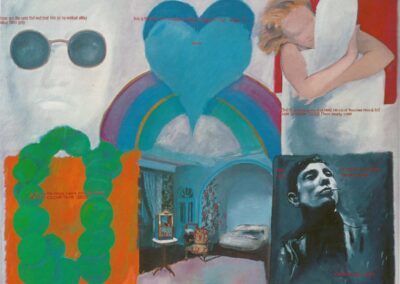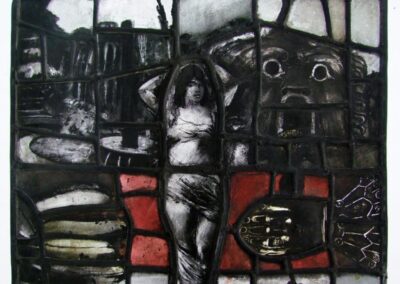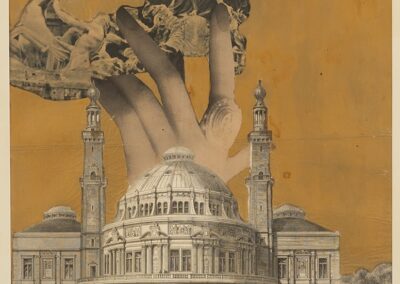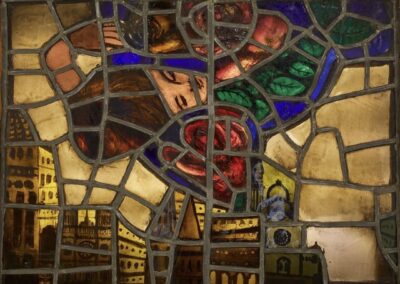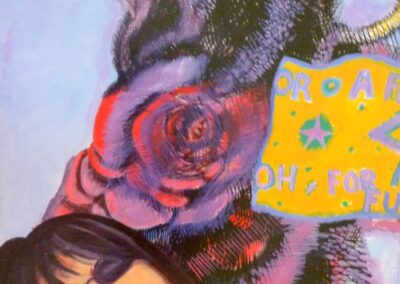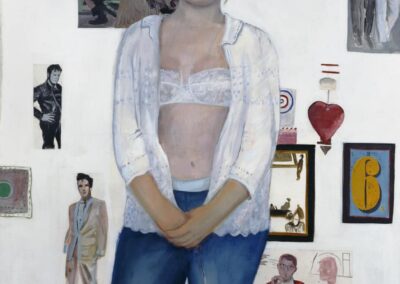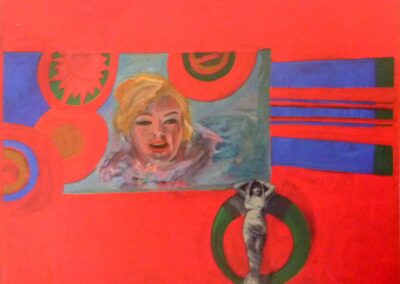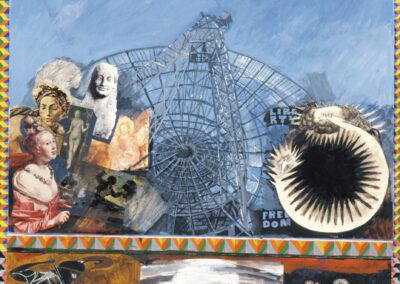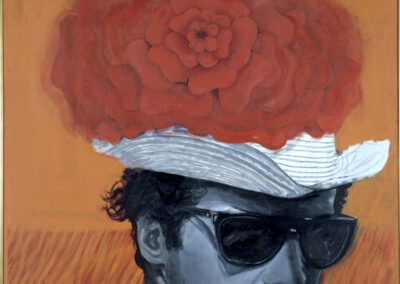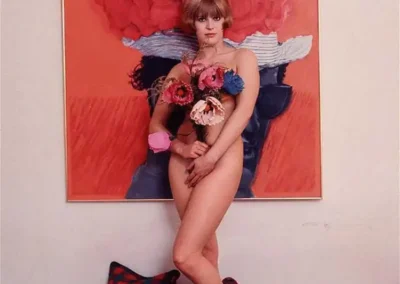Our next Artist You Need To Know is Pauline Boty (1938 – 1966).
Pauline Boty was a British artist (working in paint, print and collage) and co-founder of the 1960s’ British Pop Art movement as well as being the singular female member of the group. Her artworks “demonstrate a joy in self-assured femininity and female sexuality, as well as criticism (both overt and implicit) of the “man’s world” in which she lived. Her rebellious art, combined with her free-spirited lifestyle, has made Boty a herald of 1970s’ Feminism.” (from here)
Boty was also an actress and dancer : the performative nature of her visual art often was a component of her public persona as one of the more recognizable contemporary female artists of her time who was unafraid to blur her position as artist with her artwork within the media and pop culture landscape that both informed and defined her time.
“A revolution is on the way, and it’s partly because we no longer take our standards from the tweedy top. All over the country young girls are starting, shouting and shaking, and if they terrify you, they mean to and they are beginning to impress the world.” (Pauline Boty, The Public Ear, 1963)
Born to a middle class catholic family with a dismissive father, Boty was the youngest of four (the other three being older brothers). In defiance of her father’s bigotries, Boty attended the Wimbledon School of Art when awarded a scholarship there and obtained an intermediate diploma in lithography (1956) and a National Diploma in Design in stained glass (1958). During this time her work became more experimental, especially in terms of collage, and with incorporating references to popular culture. Her mother was a staunch supporter of her artistic pursuits, having seen her own hopes of pursuing an artistic career dashed due to Boty’s grandfather’s religious ignorance.
In 1957 one of Pauline Boty’s artworks was shown at the Young Contemporaries exhibition alongside work by Bridget Riley. Boty would also attend the School of Stained Glass at the Royal College of Art (1958–61). Despite the institutional bias towards women, she was one of the top students in that sphere, and in 1960 one of her stained-glass works was included in the travelling exhibition Modern Stained Glass organised by the Arts Council. Her work in stained glass was in tandem with her continued painting and collage works : in 1959 she had three more works selected for the Young Contemporaries exhibition.
After graduation, Boty began working as a dancer, actress, radio contributor, set designer, and model.
In 1962 British filmmaker Ken Russell “made a 45-minute film for the BBC arts show Monitor called Pop Goes the Easel, about four up-and-coming young pop artists: Peter Blake, Derek Boshier, Peter Phillips, and Boty. Pop Goes the Easel has never stopped being seminal. There had never been a film quite like it. It also happened to be the first TV documentary to feature pop music as its soundtrack, and, like much of Russell’s TV work, it wasn’t just strikingly original for its time, it still is, more than 50 years later.” (Ali Smith, from The Guardian)
You can see Pop Goes the Easel (in its entirety) here.
In speaking about her interest and use of pop culture, especially movies and film, Boty stated that “Film stars are the 20th – century gods and goddesses. People need them, and the myths that surround them, because their own lives are enriched by them. Pop art colours those myths.”
Artist and Art Historian Cat Askew, writing about Boty’s artwork in 2022, offered the following : “[Pauline Boty’s] work is inexplicably linked to her experience as an expressive, sexually free woman of her time. Her paintings joyfully communicate the intensity of the dream sensation achieved when indulging in media fantasy. She perfectly married this with the mystique of female pleasure. Boty passionately advocated for the shared experience that popular culture provided, combining high and low culture in her works.”
Pauline Boty was diagnosed with cancer during a prenatal exam : she declined chemotherapy, fearing it would harm her child. She was still very active artistically during her illness, and her daughter was born in February of 1966 : Boty would succumb to cancer later that year at the age of 28 (the same age as another previously featured Artist You Need To Know – Amrita Sher – Gil).
Boty’s work can be found in the collections of the Smithsonian American Art Museum, Tate Museum (London), and the National Portrait Gallery (London) : an extensive listing of exhibitions of her work (both while alive and posthumously) can be seen here.
Regrettably, many of Pauline Boty’s works have been lost as the history of the British Pop Art movement was rewritten and dominated by a more misogynist narrative. As she remarked in the early 1960s : “Lots of women are intellectually more clever than lots of men. But it’s difficult for men to accept the idea.”
In 1990, curator David Alan Mellor uncovered a significant amount of Boty’s work in her brother’s barn : the condition was as poor as might be expected. Mellor did his best to restore a number of Boty’s artworks and mounted an exhibition at the Barbican in 1993. This marks the beginning of a more appropriate consideration of Boty’s place in the history of British – and Pop – Art. A good article about her lost works and efforts to locate those still missing can be seen here.
In 2013 Sue Tate curated the first major exhibition of Boty’s work since her death at the Wolverhampton Art Gallery : Tate had also published a book about Boty titled Pauline Boty: Pop Artist And Woman. Scottish author Ali Smith published a novel in 2016, titled Autumn, within which the work of Pauline Boty was a major element (this was short listed for the Booker Prize in 2017 and the New York Times recognized it as one of the ten best books of the same year). Another book about her – Pauline Boty: British Pop Art’s Sole Sister – was published by Marc Kristal in 2023 (more information here) and in July of 2023 a commemorative plaque to honour Boty’s importance as an artist and groundbreaking work as a feminist artist was unveiled in London.
In recent times, more appropriate attention has been paid to Boty’s work and legacy (the New York Times featured her in one of their Overlooked No More articles in 2019). A site dedicated to her life and work can be seen here : this page has a plethora of articles and interviews (such as with curator Sue Tate) that offer a deeper exploration of Boty’s artwork.
The Art Story also offers a fine timeline of her career and more in depth information about her important works.
The following quote has been attributed to Pauline Boty, and seems an appropriate way to end :
I am the Sixties
I am Pop
I am Art
You just didn’t realise…


